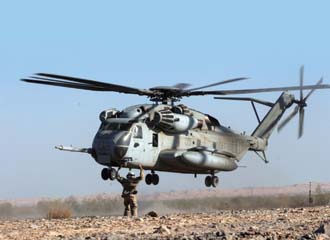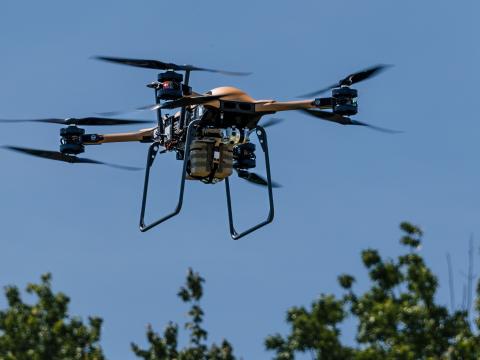360 Degrees to Afghanistan
 |
The U.S. Marine Corps Common Aviation Command and Control System (CAC2S) will help direct Marine Corps aviation activities in Afghanistan. |
A modernized aviation command and control system for the U.S. Marine Corps likely will be deployed to Afghanistan before the year is out. The new system provides a common aviation command and control platform and is expected to improve situational awareness and information assurance while making the Marine Corps fighting forces more mobile.
According to military documentation, the Marine Corps’ Common Aviation Command and Control System (CAC2S) provides closer coordination of the Marine ground and air C2 centers, allowing more speedy responses to changing battlefield conditions. Possible responses include providing artillery fire, dispatching unmanned aircraft and launching or redirecting helicopters or fighter aircraft. The system is designed to be a scalable, modular and flexible communications system with an open architecture design that can be deployed on a Humvee within 24 hours of receiving a movement order. It also can be transported by helicopter, airplane, amphibious ship and landing craft. CAC2S is designed to provide Marine Corps operators the ability to share mission-critical voice, video, sensor and C2 data and information to integrate aviation and ground combat planning and operations in support of the Marine Air Ground Task Force (MAGTF).
The MAGTF commander, the documentation explains, will be able to employ the system in support of operational maneuver from the sea, sustained operations ashore and other expeditionary operations. It also will enable commanders to command and control assigned assets afloat and ashore in allied, joint or coalition operational environments by displaying a common tactical data picture. The tactical picture will facilitate C2 of friendly assets and the engagement of threat aircraft and missiles and will provide access to theater and national intelligence sources from a single, multifunction C2 node.
The pending deployment into Afghanistan marks a major turn-around for a program that was restructured in 2009 because of an array of technical difficulties. The previous solution was proceeding toward an initial operating test but faced hurdles related to network stability, information assurance, implementation and other technical challenges.
Real Time Real-time data: Near-real-time data: Non-real-time data: |
The system was fielded to the Marine Corps Communications-Electronics School, Twentynine Palms, California, in December and began fielding in January to the Marine Air Support Squadron III, Camp Pendleton, California. The Marines expected to declare initial operational capability officially in February.
The fielding effort follows a successful prototype demonstration in December, which saw a face-off of four competitors—Boeing, Northrop Grumman, General Dynamics and Thales-Raytheon Systems. “The demonstration was very successful. Everything we saw from the contractors exceeded our expectations. They brought more capability pretty much off the shelf than what we had anticipated. It was a first-class demonstration,” Capt. Costello states. The military likely will choose one contractor in the third or fourth fiscal quarter of this year.
The main capability of CAC2S will be implemented with the Tactical Air Command Center, the Tactical Air Operations Center and the Direct Air Support Center. At those three centers, it will replace a number of non-integrated legacy systems. The Tactical Air Operations Center manages assets for the Marine Air Wing. The Tactical Air Operations Center performs air surveillance and controls air-to-air fighter and air defense operations; and the Direct Air Support Center communicates with aircraft and coordinates air assault, close air support, battlefield air interdiction and other air operations supporting Marines on the ground.
The Direct Air Support Center currently relies strictly on radio voice communications and paper maps, so to have a digital display of both air and ground assets immediately improves situational awareness. Those centers with digital systems currently available rely on different systems for awareness of the ground and air picture.
“We’re integrating the air and ground picture—whether it’s real-time, near-real-time or non-real-time data—into a common display for the operators, so that they have complete situational awareness across the battlespace to execute the mission,” Capt. Costello explains. In addition, the program will integrate the Navy’s Cooperative Engagement Capability, which is a real-time sensor fusion network capability, so that ships—such as cruisers, destroyers and carriers—receive the full land radar picture.
CAC2S at a Glance CAC2S consists of threee subsystems: The processing and display subsystem, which provides the operational command post and functionality to support mission planning, decision making and execution tools for all aspects of Marine aviation; the communications subsystem, a Humvee-mounted radio suite that interfaces with an array of other systems; and the sensor data subsystem, which provides an open architecture interface capable of integrating emerging active and passive sensor technology for the Marine Corps Air Command and Control System. |
CAC2S also will substantially improve mobility. “We’re reducing the footprint of the system pretty significantly. We go from a system that’s in 10 x 20-foot shelters to a Humvee-based system,” Capt. Costello adds.
The restructured program was divided into two phases. The first was designed to achieve a baseline system as rapidly as possible. “We took essentially off-the-shelf software components and commercial hardware, such as servers, routers and displays, and integrated them together to provide a baseline capability that brings in the near-real-time air picture and the near-real-time and non-real-time ground picture,” Capt. Costello explains. “Phase two brings in the real-time data—the sensor radar data. We carved that off as a separate phase because it is technically complex to bring in the real-time sensors.”
Phase two includes development of the sensor data subsystem, which will integrate input from a wide spectrum of sensors, including the planned Ground/Air Task-Oriented Radar, tactical datalinks, ground force command and control centers, weapon systems, unmanned aerial vehicles and the planned F-35B Joint Strike Fighter.
The Marines plan to purchase a total of 50 systems. In an era of budget slashing, CAC2S is fully funded and the first phase of the program came in under budget, returning some money back to the Marine Corps.
WEB RESOURCE
CAC2S: www.marcorsyscom.usmc.mil/peolandsystems/cac2.aspx



Comment
I would love to hear from
Comments